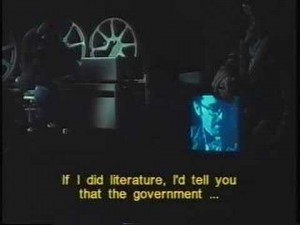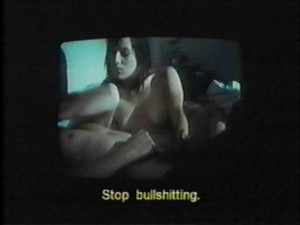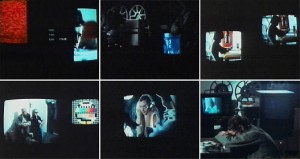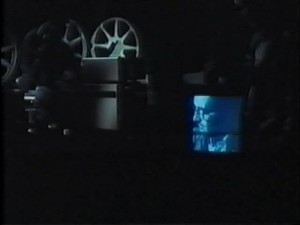Written for a Portuguese exhibition catalogue in Fall 2016. My affectionate thanks to Nicole Brenez for both landing me this assignment and correcting a few of my imprecisions.– J.R.
1. On a film by Jean-Luc Godard
I’ll never forget the very strange sort of non-reception that appeared to greet the challenge of Jean-Luc Godard’s Numéro Deux when it first appeared in France, the United Kingdom, and the United States. The first time I saw the film, in the mid-1970s, soon after its unexpectedly wide commercial opening in Paris — a release apparently prompted by the misleading claim that it was a “remake” of A bout de souffle (premised on the fact that it had the same producer, Georges de Beauregard, as well as the same budget, without allowing for any inflation), plus the fact that it was being distributed by Gaumont — was at a large cinema just off the Avenue des Champs-Elysées, where I was startled to find myself the only person inside the auditorium. Communing all alone with that big screen containing many smaller screens was a singular experience in more ways than one.
When Numéro Deux was subsequently shown at the Edinburgh Film Festival, the key annual event of Marxist film theorists in the United Kingdom, many of the intellectuals associated with Screen magazine who had previously treated Le gai savoir and Vent d’est as exemplary manifestos for a political “counter-cinema”, quoting from its various speeches as if they were all graspable and teachable recipes for a revolutionary practice, abruptly dismissed Numéro Deux for its alleged “sexism” and “mystifications” (if they bothered to discuss it at all). At the same festival, I recall New York experimental filmmaker Yvonne Rainer declaring to me, in a burst of anger, “Bare ass is bare ass — I don’t give a goddam how many video screens you put it on.” And in New York, Godard’s main U.S. distributor, Daniel Talbot of New Yorker Films, flatly refused to handle the film because, as he expressed it to me somewhat later, he considered the sequence of the “primal scene” (Vanessa, a little girl in superimposition, witnessing her parents’ anal intercourse) to be “psychotic”. The film eventually premiered in New York in the early 1980s only because filmmaker and programmer Jackie Raynal agreed to show it without a distributor at the Bleecker Street Cinema, along with Ici et ailleurs and Comment ça va.
After the flood of theoretical and critical discourse in the English-speaking world that was inspired by Godard’s previous work in the 1960s and 1970s, it’s worth inquiring what provoked the relative shock, consternation, and virtual speechlessness occasioned by Numéro Deux.
Clearly part of this impasse came from the radical departures of the film from Godard’s earlier practice — which still makes it, for me, the most purely experimental of Godard’s works, even though it clearly gave rise to some of the procedures involving multiple images in his subsequent works (most notably, Histoire(s) du cinéma and its multiple annexes). Indeed, it was these radical departures in signification that led me to borrow a 35mm print of the film in order to study it on a movieola for a few hours at the British Film Institute, where I was employed at the time, in preparation for my review of the film in Sight and Sound (Spring 1976). Regrettably, almost all I could accomplish by this was to clarify to what extent the film and its complex processes of signification eluded my grasp. My principal “hook” was the fact that, as in 2 ou 3 Choses que je sais d’elle, another CinemaScope feature, Godard was dealing with questions of representation in relation to a working-class French family, although in this case, the family had six members instead of three, encompassing three generations, and all of them were played by nonprofessionals; furthermore, almost the entirety of the film was shot on video and inside the family’s flat, bracketed by 35mm film segments featuring Godard himself (whose “appearances” in 2 ou 3 Choses were restricted to his whispering voice, reflecting on how to present and think about his images).
Fortunately, other writers have succeeded much better than I did in elucidating the achievements of Numéro Deux in subsequent decades—most notably, in my experience, David Sterritt in The Films of Jean-Luc Godard: Seeing the Invisible (Cambridge University Press, 1999), Kaja Silverman and Harun Farocki in Speaking about Godard (New York University Press, 1998), and, more recently, Nicole Brenez (see #3, below), in her essay “En Reconstruction” (included, along with Silverman and Farocki’s dialogue, in Numéro Trois: Variations sur Numéro Deux de Jean-Luc Godard (a.p.r.e.s éditions, 2013). All three of these texts are especially attentive to the interlocking and complexly interrelated themes, metaphors, and audiovisual procedures of the film involving work, sex, leisure, family, and culture. By contrast, the most that can be said for my Sight and Sound review is that it ended by broaching the same notion of a “fertile” darkness that would be developed much further by Brenez: “A stand-in for neither the characters nor the spectators but a mediator between these distant worlds, [Godard] occupies a distinct darkness of his own — an extension of the blackness surrounding [the] TV screens and cinema screen alike, contiguous with both, identical to neither. All three forms of darkness suggest a womb in which meanings are spawned. ‘Before being born, I was dead,’ Vanessa copies on a blackboard. ‘Do all little girls have holes?’ she asks her mother while taking a bath. ‘Is that where memories come out?’ Simultaneously destructive and constructive in its flight back to zero, Numéro Deux situates the loss of memory and the birth of signification on the same dark and slippery but fertile terrain — a factory-landscape where anything becomes possible.”
2. On a trailer for a film by Jean-Luc Godard
Roughly thirty-five years before Godard provided a trailer for Film Socialisme (2010) by speeding up and squeezing its one hundred and two minutes into ninety-three seconds and then overlaying a few pithy and relevant intertitles over the results, he performed an almost comparable digest of Numéro Deux’s eighty-eight minutes into four minutes and fifty-six seconds, this time by extracting, shuffling, and juxtaposing several extracts from the film, including what appears to be a brief trailer that is already embedded in the middle of Numéro Deux itself. Missing from this new film—more experimental and more deconstructive than the feature it advertises, but also far more pointed in spelling out many of its themes and procedures—is all of the 35mm footage bracketing most of the feature and showing Godard himself, either delivering a monologue or slumped over a table in his editing studio. In this respect, it is strikingly similar to Orson Welles’ nine-minute F for Fake trailer, produced around the same time (1976), which not only omits Welles himself from all of the footage (apart from his offscreen voice) but takes the further radical step of offering almost entirely new footage rather than relying on extracts from the feature. Because Welles himself dominates F for Fake, this was a more radical gesture of recasting his material than anything done by Godard in summarizing and rethinking the premises of Numéro Deux, enlisting his cinematographer Gary Graver to “host” the proceedings and avoiding even having his name spoken or seen in the trailer (“Modesty forbids”), apart from including one prompt from Graver towards the end (“Ten seconds more, Orson”). By contrast, Godard employs his lead actress, Sandrine Battistella—another nonprofessional performer, like Graver—to “host” the trailer as narrator, mentioning Anne-Marie Miéville and Godard by name (as coproducers) only at the trailer’s end.
Among the many strategic sound-bites and image-bites of this trailer are evocations of porn and politics (over a shot of Sandrine masturbating her husband Pierre), “Once upon a time” and “Twice upon a time”, “regarder tranquillement” (“watch quietly”), “a film before and behind”, and the aforementioned “primal scene”, along with shots of Sandrine dancing and drinking coffee, the little girl writing on a blackboard, her brother brooding and looking bored, the grandfather watching sports on television, and the grandmother slicing carrots.
3. On a text by Nicole Brenez about a film by Jean-Luc Godard
Brenez’s “Under Reconstruction,” unlike the aforementioned texts by Sterritt, Silverman, and Farocki, mainly examines and classifies the operations of Numéro Deux theoretically and poetically rather than textually, and her analysis is split into four categories: “The fertility of black,” “The laboratory of the negative,” “The three types of external images” (classified as “disinformation [television news], mystification [mass-market cinema], and counter information [the tract]”), and “Anatomical studies”. In the first of these categories, she singles out seven sub-categories, as follows: “Violent and polysemic, the black image in Godard’s films simultaneously or alternately serves to: symbolize the way in which ideology darkens the world; break the chain of representations; erect a barrier against conventional images; attest to the impossibility of producing a revolutionary image in a capitalist world ; provide a moment for reflection; encourage the spectator to listen to the sound; construct a place for images that we do not yet know how to produce”.
Recasting and reworking some of the elements of the Numéro Deux trailer in seven separate short videos, each of which has the same exact running time (four minutes, fifty-six seconds, and twenty frames) as the trailer, collectively entitled 4.56.20, João Tabarra, working with Sophie Schiller as coeditor, has adopted Brenez’s seven sub-categories as inspirations and as apparent guidelines for each of his videos.

4. On a video by João Tabarra
In the first of these videos, adopting (and prefaced by) the fifth of Brenez’s sub-categories, “provide a moment for reflection,” the visibility of the soundtrack on the left side of the video image (consisting exclusively of brown patches of film leader, with upside down numbers which oscillate in what appears to be a random order between 3, 4, and 5) already complicates the other visual material by distracting our attention from it, and this visible soundtrack doesn’t appear to be in synch with Sandrine Battistella’s narrating voice, which we perceive only in slivers and fragments, along with the alternating sound of static which is periodically muffled and a faint, dull roar with the volume turned up.

Tabarra has chosen to interpret Brenez’s directive, “provide a moment for reflection,” not in relation to black or darkness but as a more general principle tied to film emulsion—a principle that is also expressed in Battistella’s narration, especially in the first and last phrases chosen — “regarder tranquillement …regardez quoi?… parfois on écoute, on peut regarder” at the beginning and “C’est un film qui tu peux regarder… tranquillement…honnêtement” at the end. Thus the sound literally becomes part of the image, and the image itself consists exclusively of material that is usually omitted from the projected film as it’s shown and seen.
5. On a second video by João Tabarra
In the second of these videos, adopting (and prefaced by) the seventh of Brenez’s sub-categories, “construct a place for images that we do not yet know how to produce,” there are no words, and the only image is the grandmother slicing a carrot—or, more precisely, scraping off slivers of a carrot with a knife, tiny fragments that might be said to echo the small fragments of audio and speech offered in the first video. But the steadiness of this single image is periodically broken by quick jerks that seem as involuntary as hiccups, disrupting our own sense of placement in relation to the image. For me, the serene infallibility of the grandmother’s steady activity and purposeful human gestures seems to be contested and contradicted by the mechanical fallibility of the recording device, which appears to falter at random and without apparent purpose. In this video, the relevance of Brenez’s prescribed activity is much more apparent to me — through the highlighting of the machine’s apparent “ignorance” in how to hold an image, which can render a “place” (that is, an image and an activity) only in terms of placelessness, an image and activity that neither we nor the camera can hold.
6. On a third video by João Tabarra
In the third of these videos, adopting (and prefaced by) the first of Brenez’s sub-categories, “symbolize the way in which ideology darkens the world,”darkness—and, more generally, “the fertility of [blackness]”–becomes the fixed, empty space between two video images of the same activity and event, which shows Sandrine masturbating. In the center of the ‘Scope frame is a larger video image in color and lower, on screen right, is a smaller image. Once again, as in the second video, we’re presented with a woman’s steady activity that is made unsteady through a disruption of our sense of a seamless activity, because the second image is only a blowup of the first image, endlessly repeated on a continuous loop. (We become aware of this difference between these two versions of the same event because of the wife’s repeated movement of her left arm across the frame while her right hand continues to perform her masturbation in the smaller version; in the larger image, this gesture occurs only once.) The sound here is variable, creating another form of unsteadiness—initially it’s the chirping of birds, and later the voices of children are added.
7. On a fourth video by João Tabarra
In the fourth video, adopting (and prefaced by) the third of Brenez’s sub-categories, “attest to the impossibility of producing a revolutionary image in a capitalist world,” the dialectical pattern suggested by “Once upon a time” and “Twice upon a time” is starkly illustrated in the juxtapositions within and between separate images: on a small video image at screen center, the grandfather sits in the upper left of the frame, nodding his head mechanically (in what appears to be a loop) while on the lower right is a TV set broadcasting a sports event (also seen in an apparent loop); in the left foreground is his grandson, seen indistinctly from behind as he watches the TV more directly. After we cut to a closer, trimmed, and slowed-down version of the same shot in the same screen position, we get an extended stretch of black leader followed by the son with his arms folded, seated at a table across from his sister, who is seen from behind, again at screen center. In both of these shots, it’s unclear whether we’re watching one event (the grandfather and grandson watching TV, the grandson doing nothing) or two (the grandfather doing nothing while the grandson watches TV, the grandson and the granddaughter doing nothing). Then, after we return to the trimmed and slower version of the first shot, we finally see two video images side by side: both grandparents seated on the left screen and, in a smaller image on the right, a TV screen showing a test pattern on the right, which offers a more complicated version of the same question: can we describe the subject of the shots individually or collectively—i.e., as “grandfather + grandmother and TV test pattern”, or as “grandparents watching TV test pattern?” The camera angle is such that we can’t even be sure whether the grandparents are watching anything, just as we’re uncertain whether the grandfather is watching the TV in the first image. And all we hear—or don’t hear — throughout this film is a silence that is paradoxically made to seem loud because the volume is turned up, punctuated by faint static and periodic clicks.
8. On a fifth video by João Tabarra
In the fifth video, adopting (and prefaced by) the sixth of Brenez’s sub-categories, “encourage the spectator to listen to the sound,” the only sounds we hear are (1) a brief offscreen sound-bite from Sandrine, in which the only word I can identify is “musique”, and (2) a resumption of the “loud” silence heard in the previous film. What we see is harder to synopsize, but mainly involves repetitions, extractions, and superimpositions of two separate silent shots focusing on family members that, like so many other shots in Numéro Deux, emphasizes both their physical proximity to one another and their mutual emotional alienation: in the first of these, the son, who looks bored, is eating at a kitchen table while behind him, in an open doorway, Sandrine, wearing only a bathrobe that is half-open, is dancing to unheard music, and in the second, Sandrine, seated next to the grandfather, is apparently listening to music on headphones while her daughter Vanessa is involved in some other activity at screen right. And the final shot in this film is a portion of the first shot of Numéro Deux, which includes a screen of flickering red TV static, Sandrine’s face, the words MON, TON, and SON in a vertical column, and, opposite the latter word, IMAGE, so that a multiple pun involving both the film’s production company (Sonimage) and the signification of “son” as both a personal pronoun (“his/her”) and “sound” is fully exploited.
9. On a sixth video by João Tabarra
In the sixth video, adopting (and prefaced by) the third of Brenez’s sub-categories, “erect a barrier against conventional images,” we get periodic bursts of sound-bites from Sandrine relating to “before and behind,” “landscape and factory,” and other polarities explored in the film, along with a recurrence of “par exemple,” while the images both state and problematize related polarities, e.g., Sandrine and Pierre, inside and outside the flat, asleep and awake, grandfather and grandson, brother and sister, and image and sound (as represented visually by the soundtrack).

10. On a seventh video by João Tabarra
In the seventh and final video, adopting (and prefaced by) the second of Brenez’s sub-categories, “break the chain of representations,” over the sound of noisy static, we’re presented with Vanessa writing on a blackboard, “Before being born, I was dead,” in a single image that becomes duplicated and multiplied, in escalating and overlapping profusion, like cards in a game of solitaire, suggesting the same contradictions that all of Numéro Deux and all of 4.56.20 have been exploring in various ways—the ways that addition can become subtraction, solitary can become collective, sound can become image, family togetherness can become existential loneliness, a factory can become a landscape, death can become birth, the fertility of black can become the sterility of white, and video can become cinema.





